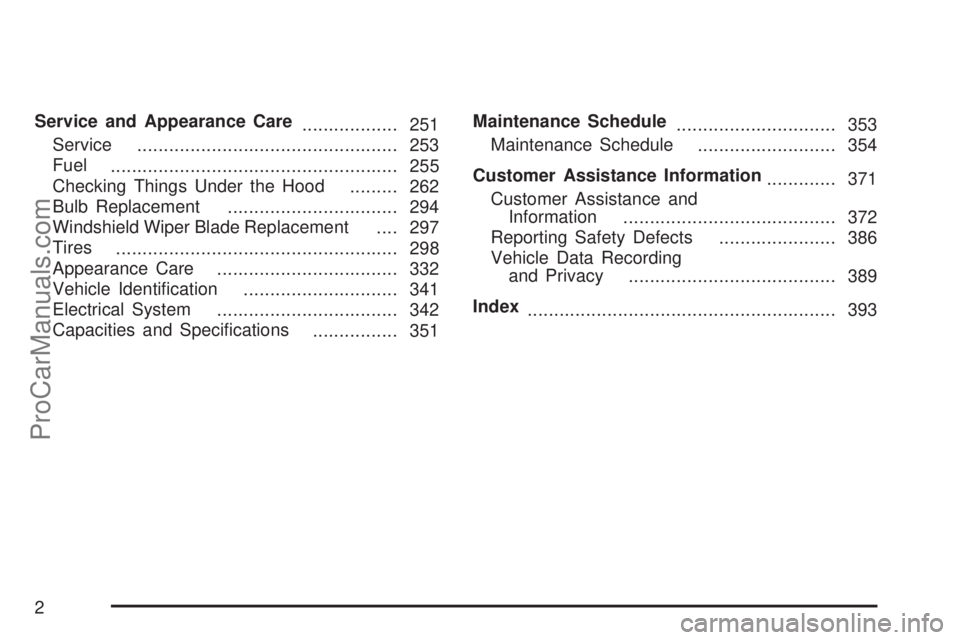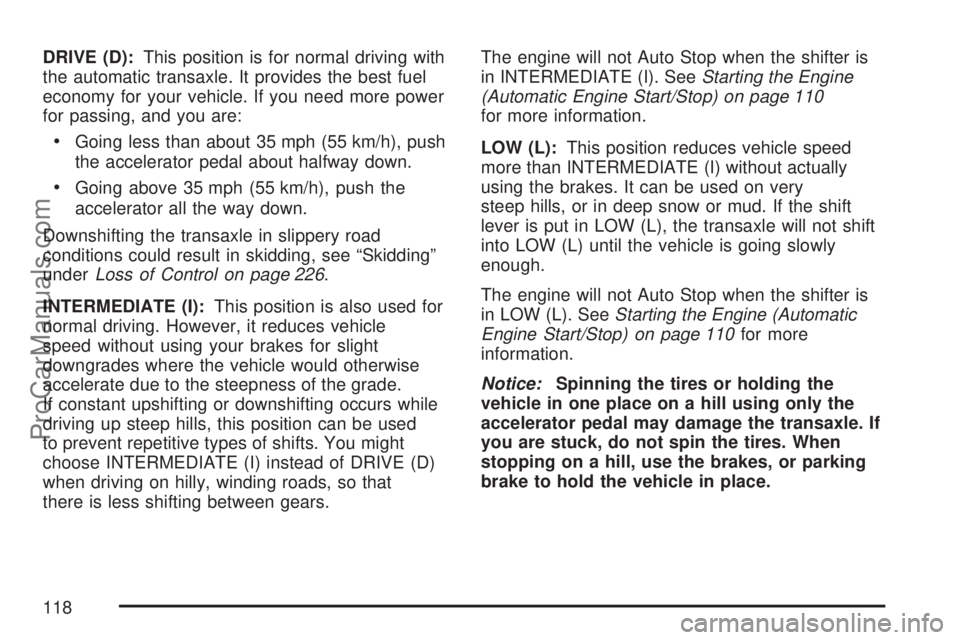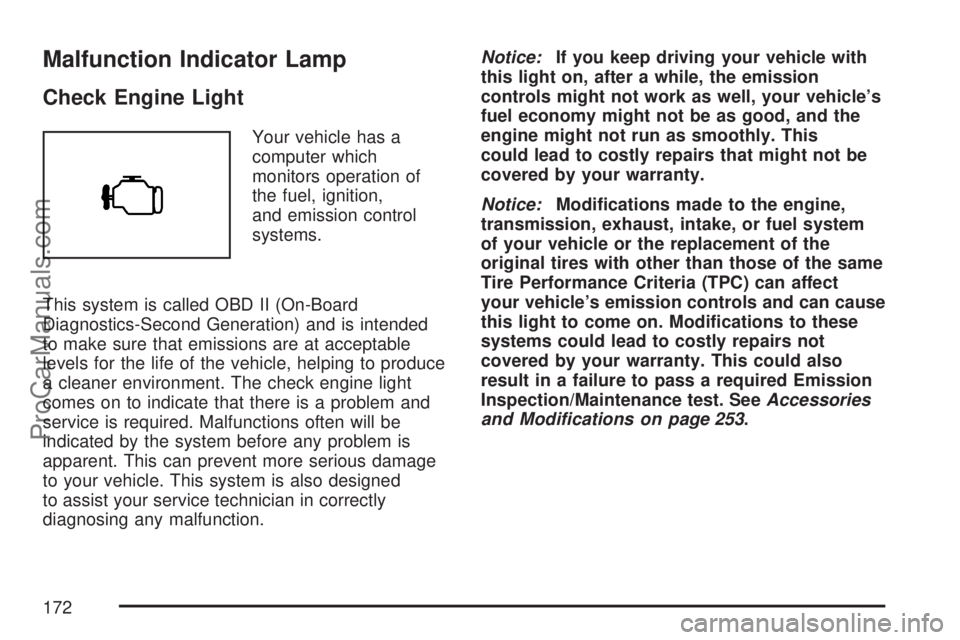fuel SATURN AURA 2007 Owners Manual
[x] Cancel search | Manufacturer: SATURN, Model Year: 2007, Model line: AURA, Model: SATURN AURA 2007Pages: 406, PDF Size: 6.49 MB
Page 2 of 406

Service and Appearance Care
.................. 251
Service
................................................. 253
Fuel
...................................................... 255
Checking Things Under the Hood
......... 262
Bulb Replacement
................................ 294
Windshield Wiper Blade Replacement
.... 297
Tires
..................................................... 298
Appearance Care
.................................. 332
Vehicle Identi�cation
............................. 341
Electrical System
.................................. 342
Capacities and Speci�cations
................ 351Maintenance Schedule
.............................. 353
Maintenance Schedule
.......................... 354
Customer Assistance Information
............. 371
Customer Assistance and
Information
........................................ 372
Reporting Safety Defects
...................... 386
Vehicle Data Recording
and Privacy
....................................... 389
Index
.......................................................... 393
2
ProCarManuals.com
Page 113 of 406

The Engine Will Remain Running When:
The engine, transaxle, or hybrid battery is
not warmed up yet.
The outside temperature is approximately
−4°F (−20°C).
When the A/C is in Normal Mode.
A/C is in Hybrid Mode and the climate control
system is working to cool the vehicle. See
Automatic Climate Control System on
page 154for more information.
Defrost is selected.
The shift lever is in PARK (P), NEUTRAL (N),
REVERSE (R), INTERMEDIATE (I) or
LOW (L).
The hybrid battery pack charge is low.
The 12V vehicle battery charge is low, or
loads are high.
The hood is not fully closed.
The Engine Will Restart When:
The brake pedal is released.
The accelerator pedal is applied.
When shifting out of DRIVE (D) to any
other gear.
If the A/C button is selected, the duration of
the AUTO STOP will depend on the outside
temperature. This economy mode improves
fuel economy by limiting the effects of the air
conditioning. The warmer it is outside, the
shorter the time before the engine is restarted
to provide cabin cooling.
The climate control system is turned from Off
to On (econ or normal A/C, or �oor/
defog/defrost) SeeAutomatic Climate Control
System on page 154for more information.
113
ProCarManuals.com
Page 114 of 406

The engine is required to run for either heater
or climate control performance. See “Air
Conditioning Engine Start/Stop” under
Automatic Climate Control System on
page 154for more information.
The hybrid battery pack charge is low and
requires recharging.
Auto Stop time is greater than two minutes.
Engine Coolant Heater
Your vehicle may have this feature. In very cold
weather, 0°F (−18°C) or colder, the engine coolant
heater can provide easier starting and better
fuel economy during engine warm-up. Usually, the
coolant heater should be plugged in a minimum
of four hours prior to starting your vehicle. At
temperatures above 32°F (0°C), use of the coolant
heater is not required. Your vehicle may also
have an internal thermostat in the plug end of the
cord. This will prevent operation of the engine
coolant heater when the temperature is at or above
0°F (−18°C) as noted on the cord.
114
ProCarManuals.com
Page 118 of 406

DRIVE (D):This position is for normal driving with
the automatic transaxle. It provides the best fuel
economy for your vehicle. If you need more power
for passing, and you are:
Going less than about 35 mph (55 km/h), push
the accelerator pedal about halfway down.
Going above 35 mph (55 km/h), push the
accelerator all the way down.
Downshifting the transaxle in slippery road
conditions could result in skidding, see “Skidding”
underLoss of Control on page 226.
INTERMEDIATE (I):This position is also used for
normal driving. However, it reduces vehicle
speed without using your brakes for slight
downgrades where the vehicle would otherwise
accelerate due to the steepness of the grade.
If constant upshifting or downshifting occurs while
driving up steep hills, this position can be used
to prevent repetitive types of shifts. You might
choose INTERMEDIATE (I) instead of DRIVE (D)
when driving on hilly, winding roads, so that
there is less shifting between gears.The engine will not Auto Stop when the shifter is
in INTERMEDIATE (I). SeeStarting the Engine
(Automatic Engine Start/Stop) on page 110
for more information.
LOW (L):This position reduces vehicle speed
more than INTERMEDIATE (I) without actually
using the brakes. It can be used on very
steep hills, or in deep snow or mud. If the shift
lever is put in LOW (L), the transaxle will not shift
into LOW (L) until the vehicle is going slowly
enough.
The engine will not Auto Stop when the shifter is
in LOW (L). SeeStarting the Engine (Automatic
Engine Start/Stop) on page 110for more
information.
Notice:Spinning the tires or holding the
vehicle in one place on a hill using only the
accelerator pedal may damage the transaxle. If
you are stuck, do not spin the tires. When
stopping on a hill, use the brakes, or parking
brake to hold the vehicle in place.
118
ProCarManuals.com
Page 119 of 406

Parking Brake
To set the parking
brake, push down the
parking brake pedal with
your left foot. If the
ignition is on, the brake
system warning light
will come on. SeeBrake
System Warning Light
on page 168.
To release the parking brake, hold the regular
brake pedal down with your right foot. Push down
momentarily on the parking brake pedal with
your left foot until you feel the pedal release. If the
parking brake is not released when you begin to
drive, the brake system warning light will be
on and a chime will sound warning you that the
parking brake is still on.The PUSH PARK PEDAL message will also
appear in the Driver Information Center (DIC) to
remind you to release the parking brake. SeeDIC
Warnings and Messages on page 182.
Notice:Driving with the parking brake on can
overheat the brake system and cause
premature wear or damage to brake system
parts. Make sure that the parking brake is fully
released and the brake warning light is off
before driving.
Regenerative Braking
Your vehicle has a regenerative braking system.
Regenerative braking takes some of the energy
from the moving vehicle and turns it back
into electrical energy. This energy is then stored
back into the vehicle’s hybrid battery system,
contributing to increased fuel efficiency.
The system works whenever you take your foot off
the accelerator pedal while your vehicle is
moving in a forward gear. This causes your vehicle
to slow down slightly faster. It may feel like the
brake pedal is being pressed, even when it is not.
119
ProCarManuals.com
Page 136 of 406

Engine Coolant Temperature
Warning Light........................................ 171
Malfunction Indicator Lamp........................ 172
Oil Pressure Light..................................... 175
Security Light............................................ 176
Cruise Control Light.................................. 176
Highbeam On Light................................... 176
Fuel Gage................................................. 177
Auto Stop Mode........................................ 178
Charge/Assist Gage................................... 178
Fuel Economy Light.................................. 179
Driver Information Center (DIC).................. 179
DIC Operation and Displays...................... 180
DIC Warnings and Messages.................... 182
DIC Vehicle Personalization....................... 187Audio System(s)......................................... 192
Setting the Time........................................ 194
Radio with CD (MP3)................................ 195
Using an MP3........................................... 200
Theft-Deterrent Feature............................. 206
Audio Steering Wheel Controls.................. 206
Radio Reception........................................ 207
Care of Your CDs..................................... 207
Care of the CD Player.............................. 207
Backglass Antenna.................................... 208
Section 3 Instrument Panel
136
ProCarManuals.com
Page 154 of 406

Climate Controls
Automatic Climate Control System
You can automatically control the heating, cooling,
and ventilation in your vehicle.
Climate Control In�uence on Hybrid
Operation and Fuel Economy
The climate control system is dependent upon other
vehicle systems for heat and power input. Certain
climate control settings can lead to higher fuel
consumption and/or fewer Auto Stops.The following are climate control settings that use
more fuel:
Normal air conditioning mode.
The defrost mode.
Extreme temperature settings, such as 60°F
(15°C) / 90F (32°C).
High fan speed settings.
The following can help reduce fuel consumption:
Use of the full automatic control method as
described under Automatic Operation.
Use hybrid air conditioning, instead of the
normal air conditioning.
Select a temperature setting that is higher in
hot weather and lower in cold weather.
Only use defrost to clear the windows.
These suggestions will help to reduce fuel
consumption, but may reduce overall comfort.
154
ProCarManuals.com
Page 158 of 406

When the weather is cool or damp, operating the
system in recirculation for extended periods of
time can cause fogging of the vehicle’s windows.
To clear the fog, select either defog or defrost.
Make sure the air conditioning is on. Allow the air
conditioning to run automatically to help
dehumidify the air.
N(Hybrid Air Conditioning):The hybrid A/C
function tries to balance fuel economy and air
conditioning comfort. When hybrid A/C is used in
warm weather, your vehicle gets better fuel
economy and/or more frequent autostops at the
expense of cabin cooling performance compared
to normal air conditioning.
Maximum Air Conditioning
On hot days, open the windows to let hot inside
air escape; then close them. This helps to reduce
the time it takes for your vehicle to cool down.
It also helps the system to operate more efficiently.
For quick cool down on hot days, do the
following:
1. Select the
Cvent mode.
2. Select the highest fan speed.
3. Select
#air conditioning.
4. Select the
hrecirculation mode.
5. Select the coolest temperature.
Using these settings together for long periods of
time may cause the air inside of your vehicle
to become too dry. To prevent this from
happening, after the air in your vehicle has cooled,
turn the recirculation mode off.
158
ProCarManuals.com
Page 162 of 406

Instrument Panel Cluster
Your instrument panel cluster is designed to let you know at a glance how your vehicle is running. You
will know how fast you are going, how much fuel you are using, and many other things you will need
to drive safely and economically.
Your vehicle has this instrument panel cluster, which includes indicator warning lights and gages that are
explained on the following pages.
United States version shown, Canada Similar
162
ProCarManuals.com
Page 172 of 406

Malfunction Indicator Lamp
Check Engine Light
Your vehicle has a
computer which
monitors operation of
the fuel, ignition,
and emission control
systems.
This system is called OBD II (On-Board
Diagnostics-Second Generation) and is intended
to make sure that emissions are at acceptable
levels for the life of the vehicle, helping to produce
a cleaner environment. The check engine light
comes on to indicate that there is a problem and
service is required. Malfunctions often will be
indicated by the system before any problem is
apparent. This can prevent more serious damage
to your vehicle. This system is also designed
to assist your service technician in correctly
diagnosing any malfunction.Notice:If you keep driving your vehicle with
this light on, after a while, the emission
controls might not work as well, your vehicle’s
fuel economy might not be as good, and the
engine might not run as smoothly. This
could lead to costly repairs that might not be
covered by your warranty.
Notice:Modi�cations made to the engine,
transmission, exhaust, intake, or fuel system
of your vehicle or the replacement of the
original tires with other than those of the same
Tire Performance Criteria (TPC) can affect
your vehicle’s emission controls and can cause
this light to come on. Modi�cations to these
systems could lead to costly repairs not
covered by your warranty. This could also
result in a failure to pass a required Emission
Inspection/Maintenance test. SeeAccessories
and Modifications on page 253.
172
ProCarManuals.com